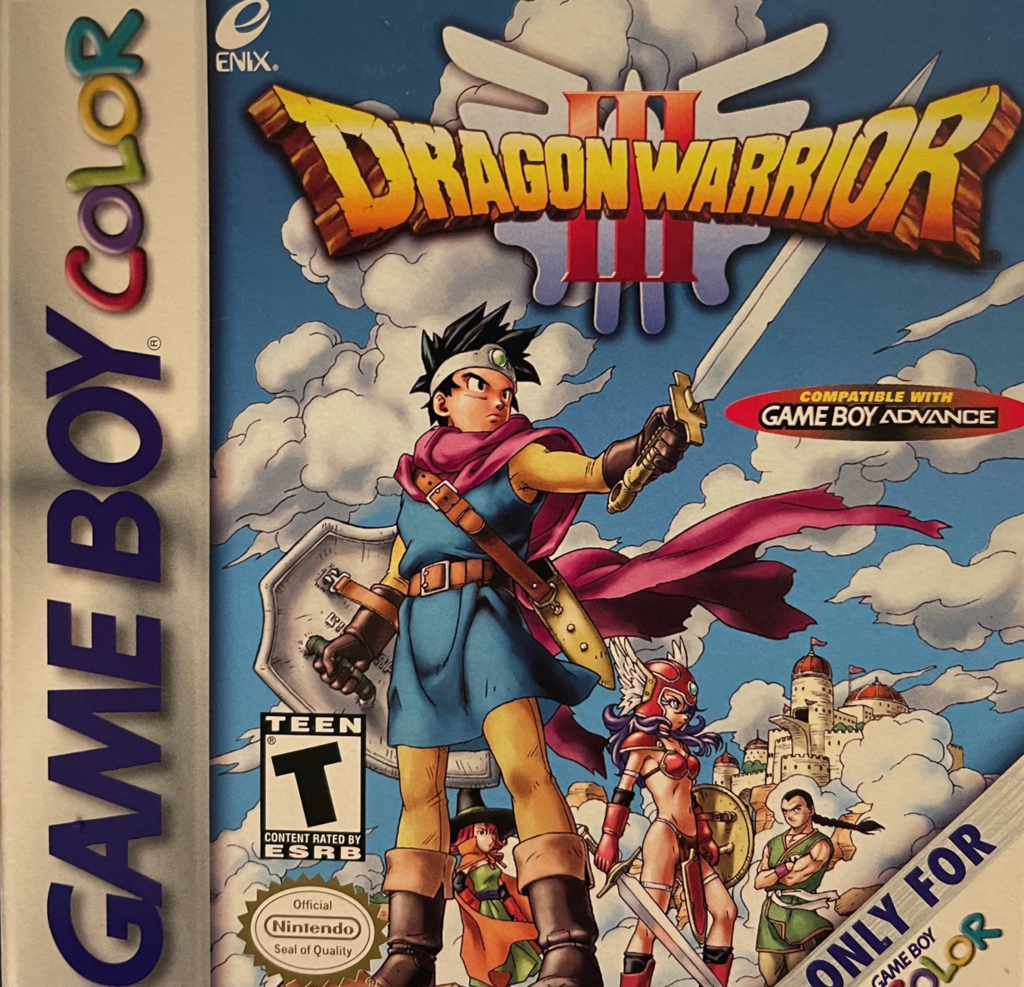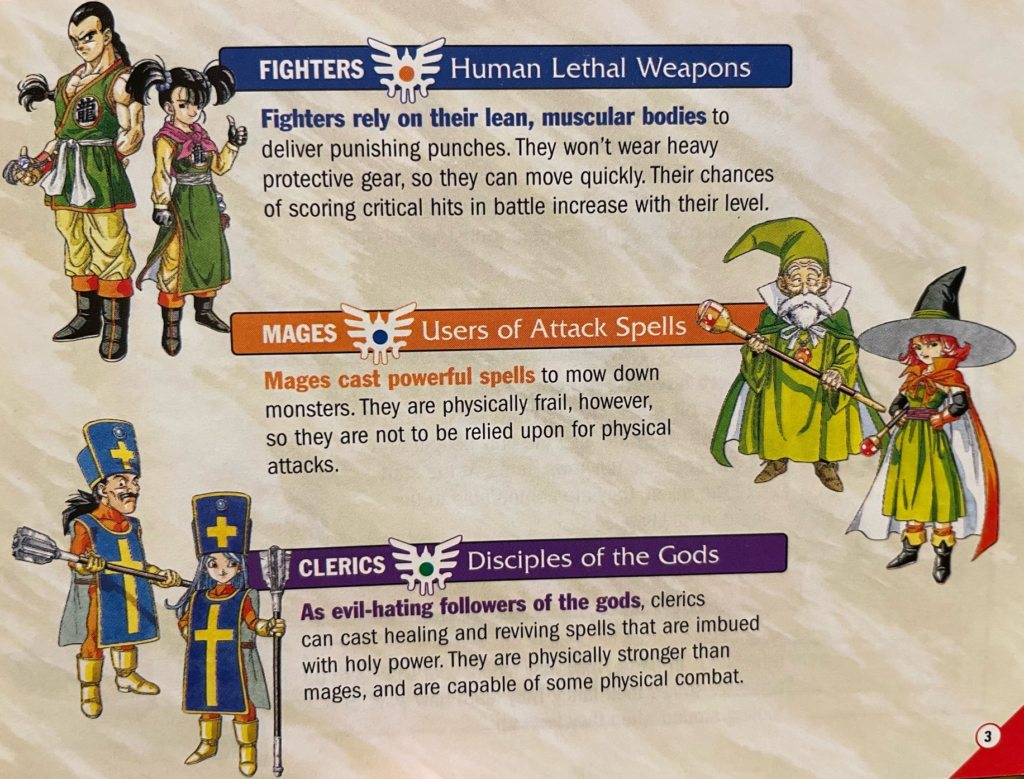For the pedants out there, we might also call this one Dragon Quest 3, as that was its original name when it was published in Japan in 1988 for the Nintendo Famicom system (and later the NES in America). But the 2001 Game Boy Color version stuck to the American naming system (I guess in the U-S-of-A “Warriors” are way cooler than “Quests”) and was released as Dragon Warrior III. It could just as easily have been published as The Greatest JRPG Ever.

Now, it’s important to make big claims like that to bait the clicks, but now we can walk that statement back a bit. There are probably better JRPGs out there, or better examples of the genre, anyway, but I don’t care—this one is the one I played endlessly and so it’s my favorite. A JRPG (Japanese Role-Playing Game) is an awful lot like a regular old RPG (even a cousin to an ARPG or Action Role-Playing Game like Diablo II), a game with characters occupying classes who have innate talents and further build skills in order to fight in turn-based or tactical battles (not live, actiony ones) and follow some (elaborate) story.

I was a little late to the RPG/JRPG party in general, and I didn’t play this game until 2001 or 2002 when it appeared for the GBC and I had picked up a Game Boy Advance. There were myriad reasons for why I’d missed out on Final Fantasy, Chrono Trigger and the like, but the biggest reason was the general moratorium in my childhood on anything magical—if you wanted magic or related dark arts you either had to play the game in secret (a la on the Game Boy, not on the family TV) or you had to read about it in some innocuous-looking library book or magazine.

But wow, this one was worth the wait. I played this game through again and again over the years, and that’s saying something because JRPGs are notoriously long. And this one just kept going—every time I thought we made it to the end of the story and my little band of heroes could finally rest, there was another twist and another chapter and another maze and another boss to defeat. And to make these adventures that much longer, you could spend as long as you needed (or wanted) grinding like mad to turn yourself into the dragon warrior you were fated to become to avenge your father’s death. Somebody could probably speedrun this game in some ridiculously short time, but every playthrough for me totaled over a hundred hours. There was so much to do, so much to fight—and that was even before you made it to the dark world.

The game is beautiful, by both 1988 and 2001 standards. Akira Toriyama (of Dragon Ball fame) was the lead artist, and the manga quality of the game’s art still shines through today. Koichi Sugiyama’s memorable musical suite added polish and delight to the massive task of walking through every grassland, forest, mountain range, and valley through the world. I usually shut off game music after an hour or two, but I always loved this soundtrack. Both the art and music remind you that adventure is hidden within the sights and sounds of the everyday.

And then there was further fun stuff they’d added that didn’t appear in the original incarnation of the game, like the Pachisi board games. Something lovely inhabited those minigames; at various stops in your treacherous journey, you could pause to walk a life-size board game and find rare items and hidden trapdoors for your trouble. Something so bright and cheery imbued what might have been a very dark Enix game. The designers had the spirit perfectly figure out of a game that was about hacking and slashing your way through serious foes, but was just as much about laughing at grinning slimes and cheering your crew through another round of Pachisi on the way to fight the Orichi.

Modern RPGs often try hard to force the tone to be serious; they want to make you feel death behind every dark door. But DW3 has no fear of running through the sunlight from town to town, joyously scouring the land of silly beasts and bosses. The crazed king who offers you his kingdom for as long as you want is a hilarious touch, the sneezy pepper plotline illustrates a lighter era of gaming, and the underpowered Jester (or Gadabout or Goof-Off) class that eventually turns conqueror, all represent the deep joy and fun of this Quest. Jesters, in particular, were a deft touch: game designer Yuji Horii and his team seemed to want always to reward players for joining in the fun of their funny medieval world, and one way they did that was by creating a wildcard class distinct from the game’s other classes—and they even gave players a reason to put up with all of its chaos.

This game introduced the experience of changing classes and party-construction for me. I spent almost as many hours on GameFAQs.com trying to figure out the best way to build my teams and tame their abilities as I did actually leading them through Alefgard. Beyond the legendary, multitalented, sacrificial Hero (your main character), you could opt to add to you team a magically-aggressive Mage/Wizard, a tanking, beastly Warrior/Soldier to soak up the hits, a Cleric/Priest/Pilgrim (how in the world were there so many versions of this game with different titles?) who could buff the party and block the enemy. Or, you could take your chances with the little-armored Fighters/Martial Artists who would practically battle naked but would take down enemies with one critical hit after another, the Thief (added in the second generation of the game’s release) who could find hidden Mini Medals. You could even venture forth with a Dealer/Merchant who could, uh, make you more money (and help with that surprisingly meaningful side-quest of founding a new town!).

The great trick that Yuji Horii came up with, though, was to make the worst class in the game the one you needed the most. The Jester/Gadabout/Goof-Off who refused to take orders and would literally do whatever he or she wanted in battle (every character could be male or female) while you simply hoped that fielding three functional teammates out of four would be enough to defeat any monsters. But once you reached level 20 you could manage a trick to convert those terrible, self-defeating, freeloading, obnoxious, hilarious clowns into the most powerful class in the game: the Sage. In DW3, upon reaching level 20 you could reset a character and give them a new class, which meant you could cycle through multiple classes with a character and add new spells from each new class (characters never lost spells they learned, even from another class).

With rare exception, only Jesters could become Sages—effectively a mage, cleric, and warrior all rolled into one. They could cast insane spells and hold their own in a physical fight. “The losers now will be later to win,” I think Bob Dylan once said. Or, “the last shall be first,”—maybe Jesus said it first. If you can put up with bad jokes for 20 levels of grinding, you could shape the greatest champion of a generation. I like a game like that, one that believes you don’t have to peak in high school—a game that agrees that there’s always more to learn, and there’s always a reason to bring a joker along on your Quest. Here’s to all the fun, friends, and frivolity of Dragon Warrior III!
